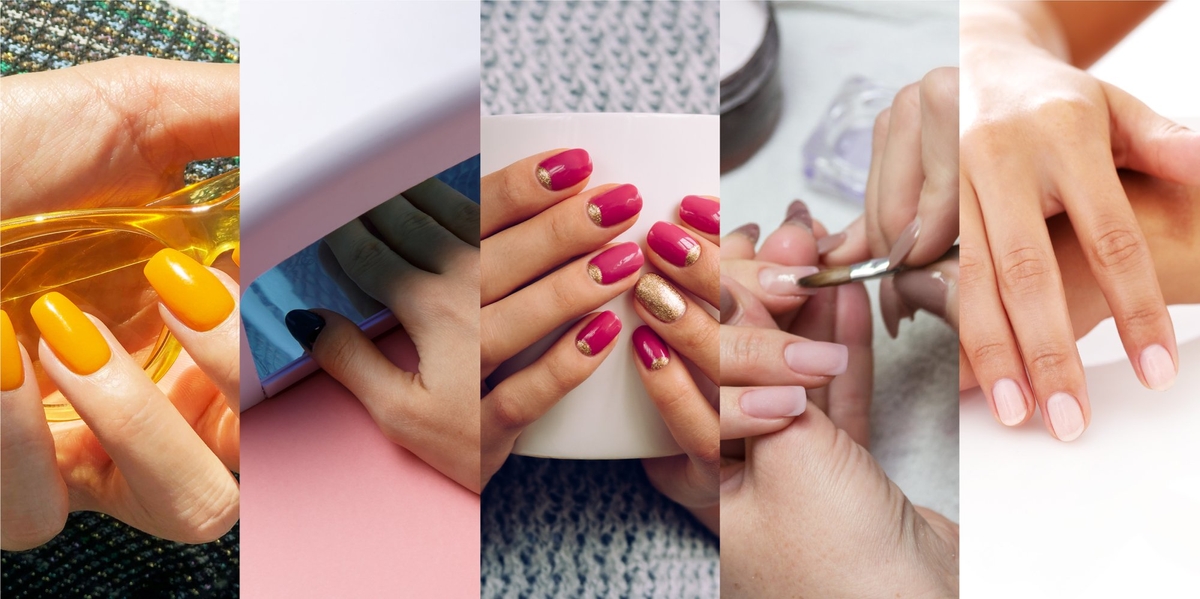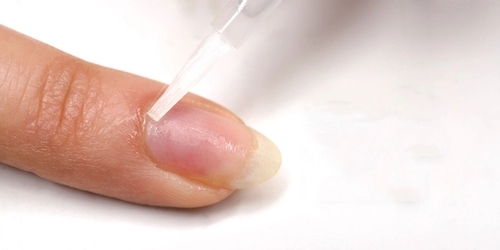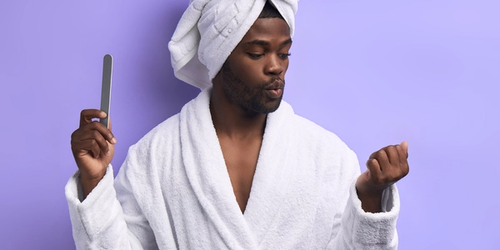Manicure options seem limitless these days. New innovations are being introduced constantly. There used to be only one way to turn your nails fire engine red, or get the perfect French tips... layers of liquid polish that would chip within a week.
Then gel nail polish arrived in salons and shook things up. Now dip nails are claiming their spot on the scene, and all the options can be overwhelming.
Today we're breaking it all down in this handy guide to manicure types.

De-Mystifying Dip Manicures
Whereas traditional liquid nail polish and gel polish are used by applying multiple layers onto the nails, the dip method utilizes layers of adhesive, colorful acrylic powder, hardening agents, and sealer to achieve an amazing-looking, long-wearing finish.
Each layer has a specific purpose: Step 2 Base is the adhesive, it acts like glue so that the acrylic powder will bind to the nail. Step 3 Activator is the hardening agent, it helps the blend of base and acrylic powder solidify for a strong mani.
The final step is a sealer, which does exactly what its name implies, it further solidifies the lower layers and provides a chip-resistant & high-gloss shine.
Benefits of dip manicures include the length of wear - they last anywhere from three to six weeks with zero chips. Um, sign me up!
Another pro of dip manis: they’re durable enough to protect your natural nails and allow them to continue growing. Women who struggle with nail biting often find that acrylic dip manis are a great way to preserve their nails.

Compared with other acrylic applications, dip manis look more natural and create a thinner surface when applied correctly. However they also give you the flexibility to create the style you want - you can achieve a thicker look by building up the layers of dip powder.
One of the top reasons fans flock to dip nails is that the application doesn't have the toxic odors associated with monomers used in traditional acrylics.
Plus, they don't require any UV light to cure, so if using a light makes you nervous, dip powder manicures are a perfect alternative to gel.
And as an added benefit, they're also easier to remove. You simply soak them in acetone (with cotton wrapped in foil). Unlike with gel manicures, dip manis dissolve more easily, meaning there’s less scraping required. And that’s good, because scraping can easily damage nails.
Most women think of dip manicures as a salon process but Dipwell kits are made for easy at-home DIY application.
Get free tutorials, special deals every week!
Sign up for fresh nail inspo & exclusive discounts delivered right to your inbox.
By subscribing, you acknowledge our Privacy Policy.

Gel Manicures - the Darling of the Early 21st Century
These have been favored by salon-goers for years, due to their no-chip durability. Gel manis involve layering a base coat and two to three layers of colored liquid, with each coat taking time to set under a UV light.
One of the big advantages of gel and powder dip manicures is that once you're done with application, you're good to go - both methods dry instantly.
Remember the days of carefully painting your nails only to mess them up minutes later? Well say goodbye to smudges!
Gel has great longevity, although it doesn’t last quite as long as a dip manicure - usually two to three weeks.
The removal process includes soaking in acetone, followed by scrapping the remaining gel with a metal or orangewood tool. A caution here: removing gel by scraping can harm the natural nail underneath if not done with extreme care and precision.
Peeling them off yourself is not recommended - when in doubt you want to protect your natural nails!
Gel manicures are usually provided at salons, but more and more brands are selling at- home gel applications. Others are creating polishes that have top coats that harden under regular light – mimicking some of the durability of gel.

When you Literally Need a New Nail Color Every Day
Don't write off regular polish completely - good old fashioned polish manicures are still alive and well.
You might have relegated polish to emergency situations only, or you might have tossed your bottles all together. But new technologies and brands are bringing nail polish into this century.
Look for formulas that are "5-free" meaning they don't have five toxic chemicals used in older blends.
Polish is definitely the quickest to apply. You only need your standard base and top coats, and in a real pinch, you can get away with just a coat of color.
It's also the easiest to remove - no long soak time or scraping needed, just some cotton balls and polish remover.
Of course, nail polish is much more prone to chips. The upside is that if you do make a mistake or get chips right away, you can touch up your nails with another coat of color and top coat.
If you like changing your nail color every few days, polish is the easiest way to do that

Low Maintenance Vs. No Maintenance
Girl, if this is your style, then you do you. Whether it's because you were born with strong, gorgeous natural nails, or because you just prefer going au naturale, you should rock your naked nails with confidence.
But if you're here reading this post, you probably want some color on those digits. If you've been hanging back because the options seem overwhelming, try one of these methods. And keep in mind that getting a salon-quality manicure can be as easy as ordering a DIY kit.
Written by: Anna Bradshaw
Get free tutorials, special deals every week!
Sign up for fresh nail inspo & exclusive discounts delivered right to your inbox.
By subscribing, you acknowledge our Privacy Policy.




